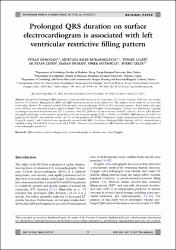Prolonged QRS duration on surface electrocardiogram is associated with left ventricular restrictive filling pattern

View/
Access
info:eu-repo/semantics/openAccessDate
2017Author
Erdoğan, TuranDurakoğlugil, Murtaza Emre
Çiçek, Yüksel
Çetin, Mustafa
Duman, Hakan
Satıroğlu, Ömer
Çelik, Şükrü
Metadata
Show full item recordCitation
Erdoğan, T., Durakoğlugil, M. E., Çiçek, Y., Çetin, M., Duman, H., Şatiroğlu, Ö., & Çelik, Ş. (2017). Prolonged QRS duration on surface electrocardiogram is associated with left ventricular restrictive filling pattern. Interventional medicine & applied science, 9(1), 9–14. https://doi.org/10.1556/1646.9.2017.1.05Abstract
Background: Prolonged QRS duration is associated with decreased left ventricular (LV) systolic function. However, the relation between LV restrictive filling pattern (RFP) and QRS duration has not been investigated yet. the purpose of our study was to assess this relationship. Methods: We analyzed standard 12-lead surface electrocardiogram (ECG) of 155 consecutive patients. Mitral inflow and septal tissue velocities were obtained using the apical 4-chamber view with pulsed Doppler echocardiography. Patients were divided into 2 groups according to measured deceleration time (DT): restrictive (with DT <= 130 ms) or non-restrictive (with DT > 130 ms). Results: QRS duration was significantly longer in the restrictive group than in the non-restrictive group (0.101 vs. 0.090 s, p < 0.0001). QRS duration of > 0.10 s was highly specific (82.6%), but modestly sensitive (64.7%), for the prediction of LV RFP. Multivariate analyses demonstrated that E/A ratio, peak E, peak A, septal e', and a' velocities were significantly associated with RFP. Conclusions: Prolonged QRS duration (>0.10 s) obtained from a standard resting 12-lead ECG is associated with LV RFP. However, the relationship of QRS duration with RFP was not independent of echocardiographic parameters.

















